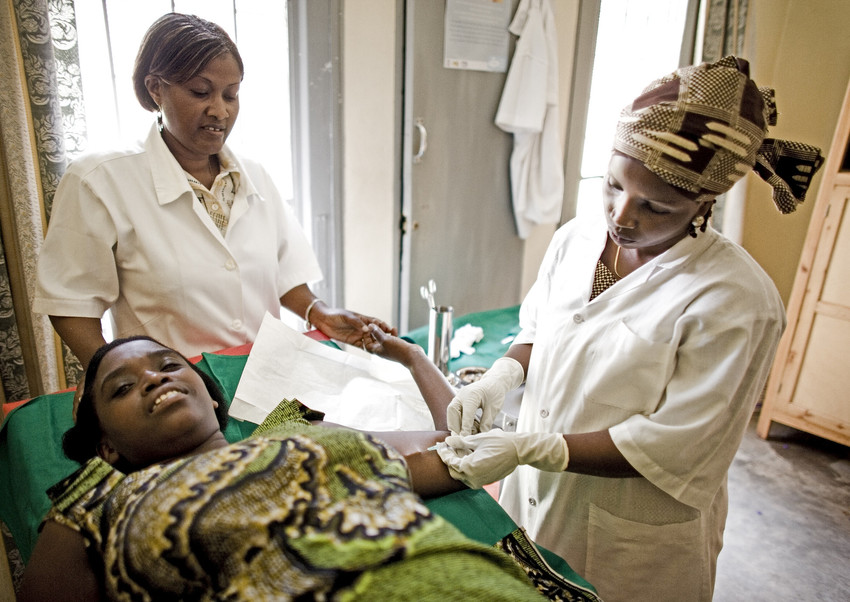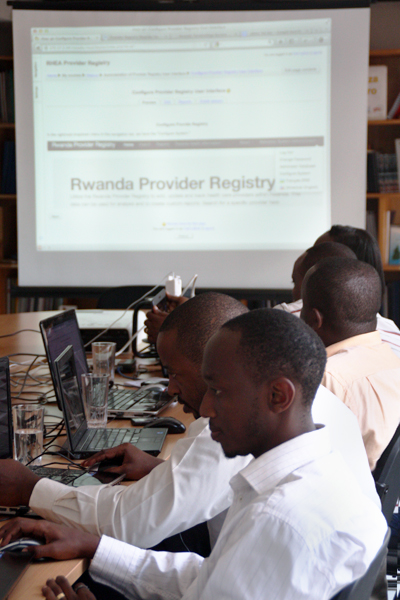
Improving Maternal Health in Rwanda by Putting Data into Health Workers’ Hands
Today a woman in Rwanda has a better chance of delivering her baby safely than she did a decade ago. Health workers are playing a big part in this achievement, along with greater access to information.
Rwanda is successfully improving maternal health, and fewer women are dying during pregnancy or childbirth. According to the World Health Organization, the country’s maternal mortality ratio was 340 per 100,000 live births in 2010, down from 550 in 2005 and 840 in 2000.
These days more births are attended by skilled health workers (69% in 2010 compared to 52% in 2008). And, thanks to a new national eHealth system, health workers in Rwamagana District now have immediate access to a mother’s health information—even from another clinic, or from data captured in the community—to make informed decisions about which services to provide. These can range from prevention of mother-to-child transmission of HIV to active management of the third stage of labor, a WHO-recommended technique to prevent postpartum hemorrhage.
Previously, a health worker could only access information about a patient from prior visits to that specific clinic. This is of little help to the clinician or the mother, who was likely identified as pregnant by a community health worker, is receiving prenatal care at a nearby clinic, and will deliver her baby in a district hospital.
A new eHealth system
In September, the Rwanda Ministry of Health launched a new kind of eHealth system, an open health information exchange (HIE), created by the Ministry with funding and support from PEPFAR and the Rwanda Health Enterprise Architecture project and its partners, including CapacityPlus. 
The HIE, now being used in Rwamagana District, provides health workers working in 15 clinics with up-to-date information about pregnant women’s medical records and histories. The HIE model enables continuity of care throughout the mother’s pregnancy and birth regardless of where or when she receives antenatal care.
The HIE brings together several free and open source health information systems, including CapacityPlus’s iHRIS platform of tools for the health workforce, DHIS 2 (a district health information system that tracks service delivery and disease statistics), OpenMRS (a medical records system that stores and maintains patient data on clinical encounters), and RapidSMS (a mobile clinical support system for community health workers). These software components that used to be separate can now share data.
These systems work with a collection of central registries—including a patient registry, a facility registry, and a provider registry—to create a shared electronic medical record.
The HIE is providing shared electronic medical records for expectant mothers receiving services at 15 prenatal clinics in Rwamagana District. The shared records combine information about clinical services received, lab results, and orders given during each visit to any of the clinics. Only health workers included in the special provider registry can access this information.
A new provider registry  CapacityPlus developed the Provider Registry on the iHRIS platform, which includes the iHRIS Manage software already used by Rwanda and 12 other countries. The Provider Registry will serve as a centralized database for all providers of health care services. Currently it pulls together basic information on health workers from iHRIS Manage and includes information on all prenatal care providers working in the 15 clinics. The registry also incorporates community health worker information from RapidSMS, and will routinely link with that system as a source of data in addition to iHRIS Manage in the near future.
CapacityPlus developed the Provider Registry on the iHRIS platform, which includes the iHRIS Manage software already used by Rwanda and 12 other countries. The Provider Registry will serve as a centralized database for all providers of health care services. Currently it pulls together basic information on health workers from iHRIS Manage and includes information on all prenatal care providers working in the 15 clinics. The registry also incorporates community health worker information from RapidSMS, and will routinely link with that system as a source of data in addition to iHRIS Manage in the near future.
Rwanda is well known for its commitment to technology for improving the health of its people. Rwanda was the first country to implement iHRIS Manage, open source software for managing health workers. iHRIS Manage is installed at the central level, and HR managers access the system to manage health workers in their districts. The system contains information on 20,000 employed health workers, including where they are posted, salary history, promotions and transfers, qualifications, and reasons for attrition. Health leaders use the system to identify and track vacant positions and make decisions about the health workforce.
Advantages of open source software
Free and open source software is available to download and customize at no cost. The power of open source approaches to foster collaboration and interoperability cannot be underestimated. Each component of the HIE was developed by a separate global health organization, yet by adhering to open source technology and standards the organizations were able to quickly come together and create a whole more powerful than any of the components.
CapacityPlus’s Dykki Settle is a key consultant and architect for a new OpenHIE collaborative organized by PEPFAR. “The HIE in Rwanda is the realization of a long-standing vision of the global health informatics community,” he says. “It is the first comprehensive national health information system composed of separate but interoperable components. Each component has been built by different teams in the global eHealth field.”
Instead .jpg) of spending money on software licensing fees and future upgrades—required for off-the-shelf software—Rwanda can invest in building local capacity for programming, administration, and support of the HIE. CapacityPlus is a partner in this work and is continuing to strengthen the Provider Registry and iHRIS Manage.
of spending money on software licensing fees and future upgrades—required for off-the-shelf software—Rwanda can invest in building local capacity for programming, administration, and support of the HIE. CapacityPlus is a partner in this work and is continuing to strengthen the Provider Registry and iHRIS Manage.
Starting in January 2013, the HIE will be rolled out to all districts in the country and the shared medical records will be expanded from focusing on maternal health to all areas of primary and secondary care. The HIE and shared electronic medical records have been well documented and can be scaled for other countries in Africa and globally. Tanzania, Kenya, and the Philippines have already expressed interest and reached out to PEPFAR’s new OpenHIE collaborative.
OpenHIE is a global open source community that has come together to assist in the strengthening of national health information exchanges in low-resource environments. Collaborators include Apelon, The Earth Institute, HISP, InSTEDD, IntraHealth/CapacityPlus, Jembi, Mohawk College, NetHope, Sysnet International, OpenMRS, and the Regenstrief Institute.
Related items:
Photo 1 (Health workers care for a pregnant woman in Rwanda) by Charles Harris/courtesy of IntraHealth International. Photo 2 (Rwandan developers learn how to use the Provider Registry) and 3 (CapacityPlus’s Carl Leitner trains the developers) by Rhonwyn Cornell.


